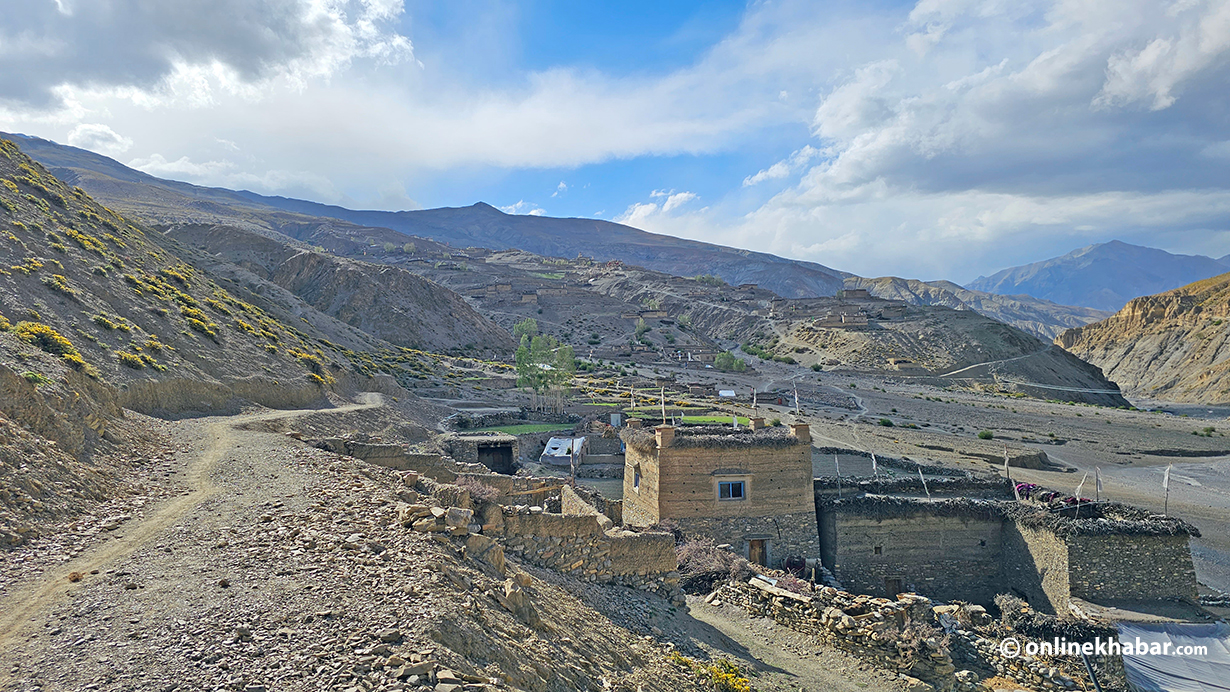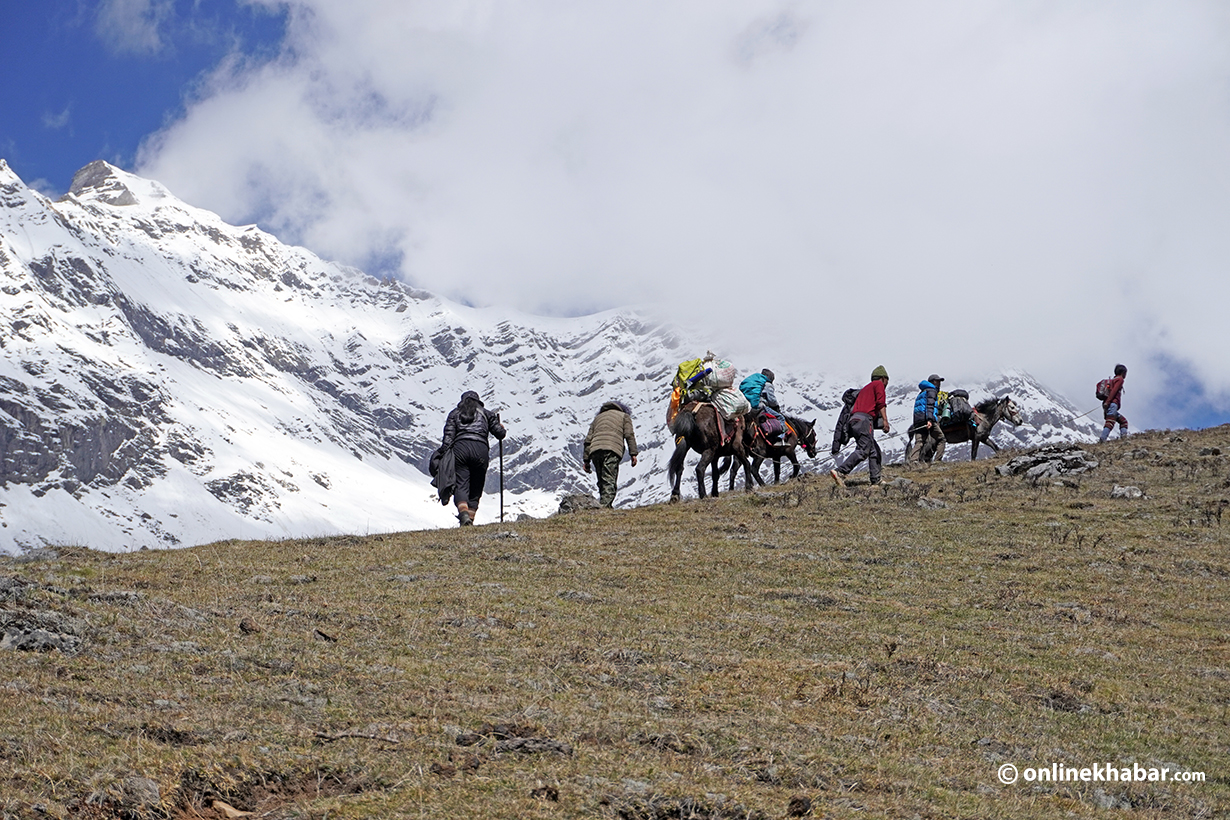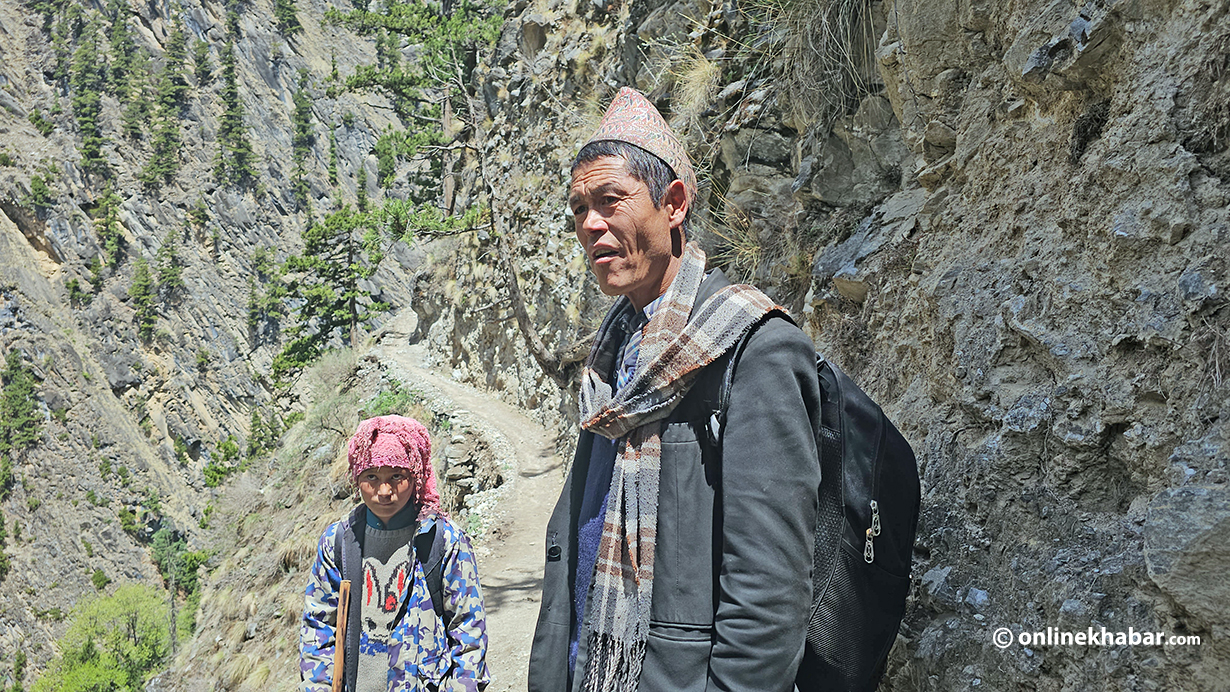
The atmosphere in Nima Lhamu’s kitchen in Saldang village, situated at an altitude of 4,500 metres in Upper Dolpa, is cosy and warm with the traditional Tibetan stove in the middle.
With the doors and windows closed tightly, all we can hear is the crackling sound of the wood fire that is serving the dual purpose of cooking and providing warmth to keep us comfortable. Despite the sun shining outside, the wind in the area is relentless. In other words, it is icy cold.
Karma Wangel, a 45-year-old local from Saldang, who had been working in the fields sowing uwa (barley), says he had to stop and seek refuge from the cold wind by coming into Lhamu’s hotel.
In this region, it is customary to welcome anyone and everyone who comes to meet with a cup of warm water before inquiring any further.
As Wangel settles down, he sips on the hot water and complains, “In the middle of May, locals are seeing heavy rains and the wind blowing vigorously. Just a day ago, there was even snowfall at Shey-La (pass). Now it’s windy.”
In Upper Dolpa, where the cold persists even when the sun is out, everyone enjoys sitting near a stove for warmth. In the barren hills of the region, trees and plants do not survive. This is why the locals rely on dried dung collected from animals such as mules, horses, yaks, and chauris. In each household, dried dung is commonly stored and utilised as the main source of cooking fuel.
In yesteryears, the locals of Upper Dolpa locals could predict the weather just by looking at the sky, clouds, speed and direction of the wind. They planned their day accordingly as taught by their ancestors. But things are different now.
“It’s impossible,” Wangel says, adding, “It never snowed in the middle of May. It rained heavily in October. And it does not snow in January-February.”
As the weather is changing constantly due to the effects of climate change, the knowledge obtained by people like Wangle from their ancestors is becoming useless. That is not it, the community has been greatly troubled by the scarcity of yarsagumba in the hills of Dolpa, which has been a cause for increasing worry among them.
The disappearing yarsagumba

On the foothills of Mendokting (Larcha), there are about a dozen tents buried under snow. These tents belong to the individuals who arrived in search of yarsagumba. Yarsagumba, also known as the caterpillar fungus or Cordyceps sinensis, is a major income source for the people in Upper Dolpa.
However, due to the changing weather patterns in recent years, yarsagumba has become increasingly scarce. Even those who went to the high Himalayan pastures in search of yarsagumba are now descending back without success.
Pravesh BK and Lal Bahadur Thapa from Tripurasundari municipality-3 in Dolpa reached Phulbari Patan over a month ago to search for the herb. Thapa and BK’s village is located in the central area of the national park and have to pay a fee of Rs 2,500 per person to go and search for yarsagumba.
However, they are returning empty-handed, unable to find any yarsagumba during their search.
“We have consumed all the food we had brought with us. Now we head back home,” says BK who had brought his entire family to pick the herb.
BK and Thapa, who primarily earn their livelihood through farming and manual labour for the 11 months of the year, come to Upper Dolpa every year in search of yarsagumba.
However, this year, despite spending 12 days thoroughly searching the Himalayan plains, they could not find any.
“The snow is thick, so we did not find any worms (referring to the yarsa),” says Thapa.
There are many like Thapa and BK who are coming back down as they did not find yarsagumba. Some, however, plan to go back again.
Ramila Gurung, carrying her two-month-old baby, planning to head up in search of yarsagumba. This shows the importance of yarsagumba to the Dolpali people. For them to live a sustained life, they have to go up and look for the herb that they can then sell to the highest bidder.

She has even performed gharpuja (a traditional house-worshipping ritual) in anticipation of her journey to the yarsa-rich mountains. Pointing to the two kalash (ceremonial pots) placed in her courtyard, she expresses her determination and says they will set out the following day.
The scarcity
Chandra Bahadur Mahatara, who has been venturing into the mountains in search of yarsagumba since the age of 14, was shocked this year. For the first time in his life, he returned empty-handed, without finding any yarsagumba.
Wearing a worried expression, he revealed his intention to return to the village and offer prayers to the kul deuta (ancestral deity) in the hopes of obtaining a better fortune during his next search.
In the past, the two weeks he spent in the Dolpa would give him enough money to help sustain his family.
“I would find 300 yarsagumbas and sell it. But this year, I return with nothing,” he said blaming the snowfall.

Angbo Gurung, a resident of Pugmo village in Phoksundo rural municipality-9, spent a week searching for yarsagumba. However, despite her efforts, she was unable to find any and had to leave her supplies behind and return empty-handed. Currently, Gurung has taken shelter in Rigmo village under a tent.
Gurung’s only source of money is yarsagumba. Though she returned empty-handed, she is now eyeing another area to look from yarsagumba.
“I will go there after the snow melts,” she says.
Gurung is joined by her husband, Nima Lama, who has also travelled from Pugmo village to Rigmo, eagerly waiting for the snow to melt.
Yarsagumba serves as the primary source of income for the people of Dolpa, enough for almost seven months. While farming is practised in the lower regions of Dolpa, it is insufficient to sustain the population in the upper Dolpa for even three months. According to election representative Nima Lama, yarsagumba is the ‘lifeline’ of the people here and is sold for anywhere between Rs 200 and Rs 500 per piece depending on the size and texture.
Change is evident

While many struggle to find yarsagumba, some fortunate individuals like Chandra Bahadur Budha manage to discover a significant quantity. Though hesitant to speak at first, he later expressed concerns about the risk of theft once others were aware of his find.
He handed over the bag with around 200 yarsagumba to his wife for safekeeping and shared, “We spent around two weeks in Sakpari Patan about a month ago, found the yarsagumba after digging through the snow. Now, we will sell them in Dunai, the headquarters of Dolpa.”
This seasoned individual, who has dedicated over a decade to searching for yarsagumba in the Himalayan plains, contemplates his journey and observes a noticeable decline in the abundance of yarsagumba compared to a decade ago. He, like many, attributes this change to a shift in snowfall patterns, with snow now starting in May rather than the traditional December-January months.
After successfully finding yarsagumba to meet their expenses for the year, the man’s family descends with joy. He encourages others going uphill, saying that they will find yarsagumba if they remain optimistic.
Dalbeer Khadka, from Jajarkot Barikot rural municipality-1, is engaged in cleaning the yarsagumba with a brush. He is surrounded by friends as they gather around a fire. The joy on Khadka’s face is evident as he cleans the yarsagumba.

However, he expresses concern about the decreasing number of yarsagumba in the region and the weather has played a role in the reducing number. In the past, they used to collect 100-150 yarsagumba in a day, but now they struggle to find even one worm daily due to the changing weather conditions. And Dolpa’s remote and harsh geographical conditions do not ease their struggle.
On top of that, since the outbreak of the Covid pandemic in 2019, China has closed all border crossings connecting Nepal, including the Marim and Kato crossings in Dolpa. These checkpoints are still closed, and because of this the Chinese border and unpredictable weather conditions, the people of Upper Dolpa face numerous challenges in their daily lives.
To address this issue, all three rural villages of Upper Dolpa have collectively decided to request the government to open the Chinese border. Until then, the residents have to travel to the headquarters in Dunai for essential food items like salt, sugar, and rice.
It takes three days to reach Dunai from Saldang, and transportation options are limited to horses and donkeys, as yaks and chauri cannot be taken during the summer, leading to additional difficulties, inconveniences and adding expenses, shared Dhawa Samduk Gurung, chair of Shey Phoksundo rural municipality.
The wind continues to blow outside with considerable strength. The rustling sound of the lungtar (a traditional Tibetan flag), outside Nima Lhamu’s hotel, can be heard while the wind continues to forcefully push against the door. Wangel struggles to keep the door closed as the gust of wind that enters through the door crack hits him in the chest directly.
This story was translated from the original Nepali version and edited for clarity and length.























